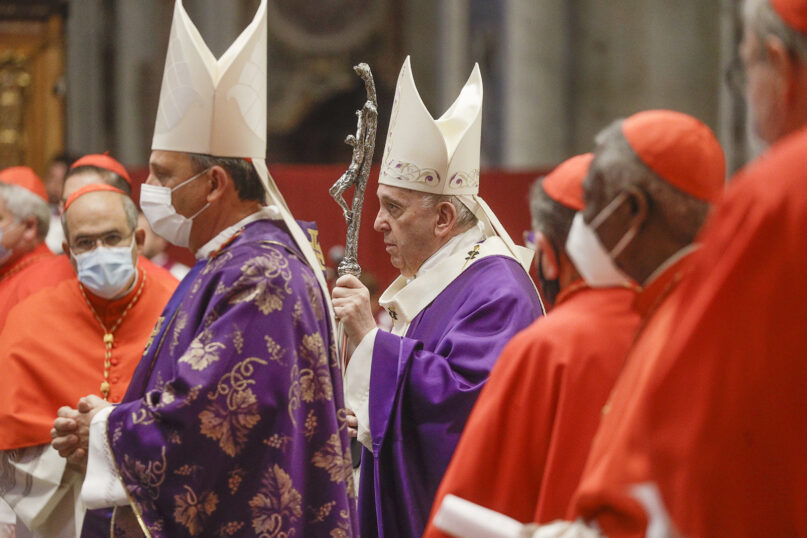VATICAN CITY (RNS) — Pope Francis gave a significant, though small, nudge in favor of greater female participation in the Catholic Church on Monday, with a new document clarifying women’s access to the ministry of lector and acolyte.
Many Catholic churches and communities already allow lay women to serve as an acolyte at the altar, read the Scriptures from the sanctuary podium and administer Communion. The document issued Monday (Jan. 11) formalizes the practice and gives the Vatican’s seal of approval by eliminating the Latin word for men, “viri,” from the relevant paragraph in canon law.
The only prerequisite to becoming an acolyte or lector now is to have received the sacrament of Baptism. “Lay persons who possess the age and qualifications established by decree of the conference of bishops can be admitted on a stable basis through the prescribed liturgical rite to the ministries of lector and acolyte,” the papal motu proprio, “Spiritus Domini,” reads.
Opening these ministries officially to laity of both sexes will increase the recognition of the “precious contribution that many laypeople, including women, offer to the life and mission of the Church,” Francis wrote in a letter to the Prefect of the Vatican Congregation to the Doctrine of the Faith, Cardinal Luis Ladaria.
The pope made clear in his letter, however, that the change is not a step toward women’s ordination. Becoming an acolyte and lector has traditionally been a precursor to becoming a deacon in the church, the lowest order of ordination. But the pope explained that recent developments have made the distinction between “lay ministries” and “ordained ministries” clearer, thereby allowing women to access the former.
The pope cited in his reasoning the final document of the 2019 Synod on the Pan-Amazon region, which called for the further participation of women and further study of how they may gain greater influence and relevance in the Catholic Church.
Some advocates for women’s ordination are not pleased with the change. Lucetta Scaraffia, a historian and journalist who formerly ran the Vatican’s magazine on women, Donne Chiesa Mondo, said the decree permanently closes the door to the diaconate to women.
The clear distinction between the acolyte and lector on one side and ordination and the diaconate on the other, Scaraffia told Religion News Service, makes it clear that women must give up any aspiration of becoming priests in the Catholic Church.
“Instead women get these two ministries, which they have been exercising for decades,” she said, pointing out that women have been seen reading the Scripture even during papal Masses. The motu proprio, according to Scaraffia, only exercises further control over women, who now must get approval from the bishops to fill these duties.
“Once the assistance of women to priests during Mass was free, but now it’s controlled by the bishops, who decide what woman may and may not perform that ministry,” she said.
“There is no novelty in this document,” she added.
According to canon lawyer Claudia Giampietro the real impact of the motu proprio will depend on how it will be received by local communities and parishes.
“The new motu proprio by Pope Francis shows that we are in a church where listening to each other and listening to the Spirit go hand in hand,” she told Religion News Service on Monday.
Women have been allowed to assist the priest at the altar, she explained, “but the Holy See has always recommended to maintain the tradition of devoting it to young men as a way to promote priestly vocations.”
In comments distributed by the Vatican, Angelo Lameri, professor of liturgy at the Pontifical Lateran University in Rome, said while the change may be underwhelming for those who advocate for women priests in the church, it would be a mistake to minimize the longer-term impact of the decree.
Lameri said the decree is a natural progression from Pope Paul VI’s 1972 Apostolic letter Ministeria quaedam, and Saint Pope John Paul II’s 1988 exhortation Christifideles laici, as well as the intentions of the Second Vatican Council.
Lameri affirmed that the change does not constitute a “promotion” for women or an opening toward forms of priestly ordination such as the diaconate or presbyterate, as the body of priests and bishops is known in official parlance.
While the door for allowing women to become priests was clearly shut by both Pope John Paul II and Pope Francis, the question of the diaconate is currently under study by a commission created by Pope Francis in August 2016.
But, Lameri wrote, priests and bishops should understand their role “as a shared mission of the entirety of the people of God, where everyone, by generously answering their vocation, identifies as a servant of Christ and his brothers.”





